Clematis Barbara Dibley - how to take care of a plant
A small liana-shaped clematis Barbara Dibley with a two-tone color is an excellent decoration for any garden. This British variety was bred by clematis grower Roland Jackman in 1947. Now the plant is grown everywhere. Consider what a flower looks like and what kind of care it needs.
- Characteristics of the variety
- Landing features
- Organization of the place
- Preparation of seedlings
- Technology
- Care features
- Watering
- Loosening and mulching
- Top dressing
- Support
- Pruning
- Shelter for the winter
- Diseases and pests
- Reproduction methods
- Dividing the bush
- Layers
- Seeds
- Application in garden landscape
- Florist reviews
- Useful videos
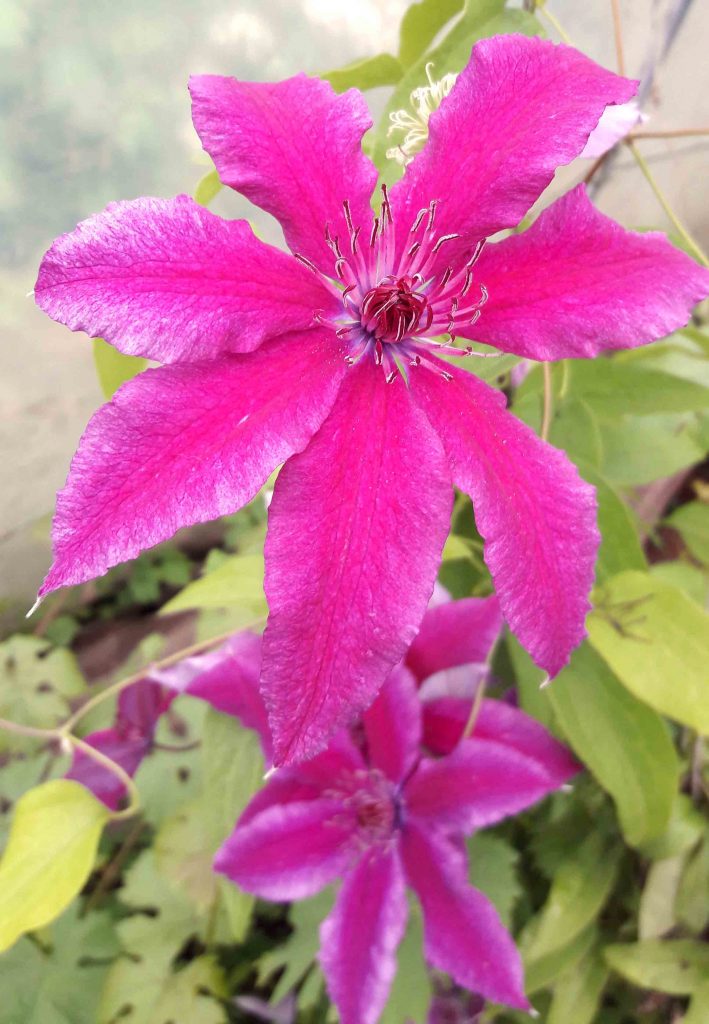
Clematis barbara
Characteristics of the variety
The botanical name of the flower is Barbara Dibley. Description of the liana plant:
- erect shoots, reach 2-2.5 m in height, internode length - 10-15 cm;
- has good growth force, suckers develop on the surface of the stems, thanks to which the vine easily clings to any support;
- trifoliate leaves, size - 9-13x4-6 cm;
- the leaf plate is ovoid, with a sharp tip, light green in color;
The inflorescence consists of 6-8 elliptical petals with pointed tips and wavy edges. Each bud blooms at the top of a flower stalk 13-15 cm long.
The flowers are oblong, erect, star-shaped, with a circumference of up to 20 cm. The color is purple-violet with a red stripe in the center.
After flowering, nut-like fruits are formed.
Landing features
Clematis requires a minimum of care and attention, so every gardener, even a beginner, can grow it.
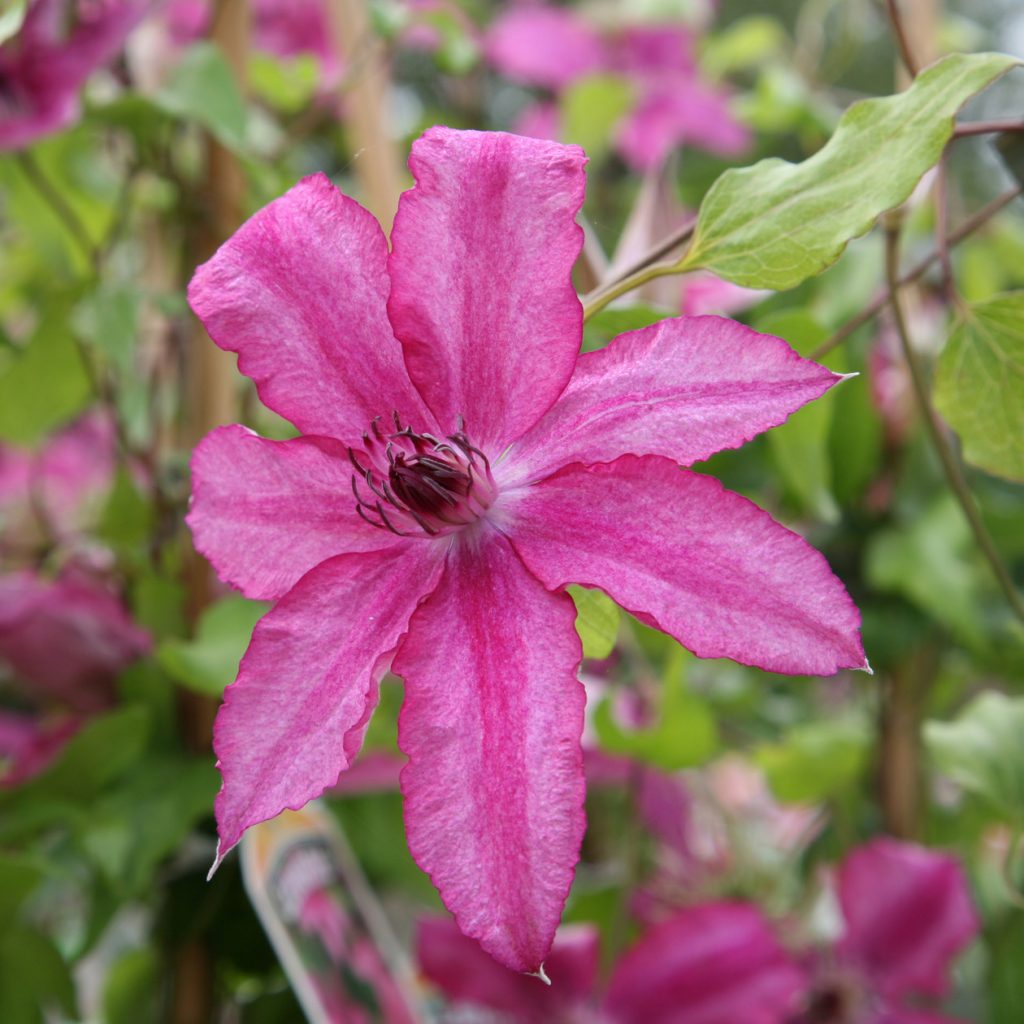
Clematis barbara jackman
These flowers are planted in spring or early fall. The timing depends on the climatic conditions of the region.
In the Urals and Siberia, spring planting will be preferable, so that the seedlings have time to adapt and take root before the onset of cold weather. In the south and in the middle lane, it can be planted in the fall.
Organization of the place
Loamy or sandy loam soil enriched with humus is suitable for cultivation. The soil should be easy to pass moisture, oxygen and be neutral in terms of acidity. If the indicator exceeds 6 units, add dolomite flour, slaked lime or chalk at the rate of 400 g per 1 m².
A place well lit by the sun will do. But clematis needs light shading at lunchtime. Therefore, the vine is planted roughly from east to west.
It is better to plant clematis in an area where groundwater lies to a depth of 1.2 m, otherwise, its root system will quickly rot and it will die.
Preparation of seedlings
You can purchase planting material in a gardening nursery, where you will be provided with a real variety with all the characteristics and qualities. Choose grown plants that have a well-grown crown and, accordingly, a massive root system. After transplanting to the site, such flowers take root easily and quickly.
Carefully inspect the aerial part - there should be no spots, blotches, growths of an unnatural tone on the stems, leaves and buds. All organs are fresh, juicy, without breaks, cracks and dry spots.
Buy seedlings in containers, because.open-rooted plants may not take root well after planting in the garden.
Technology
The site is prepared in advance:
- freed from garden debris, last year's vegetation;
- make a bucket of humus or compost for 1 m²;
- dig up and level.
After two weeks, holes are pulled out - the approximate parameters are 70x100 m. Pebbles, crushed stone, brick chips or screenings are laid on the bottom so that moisture does not stagnate at the roots. A peg is driven in or a trellis is installed for support. The garden soil is covered with a mound, the roots are lowered, straightened, sprinkled with soil up to the first internode at a height of 10 cm, tamped, watered. Water consumption - 10 liters per plant.
Until the onset of autumn, the near-trunk zone is mulched, constantly adding earth.
Care features
All care for this decorative vine comes down to several activities.
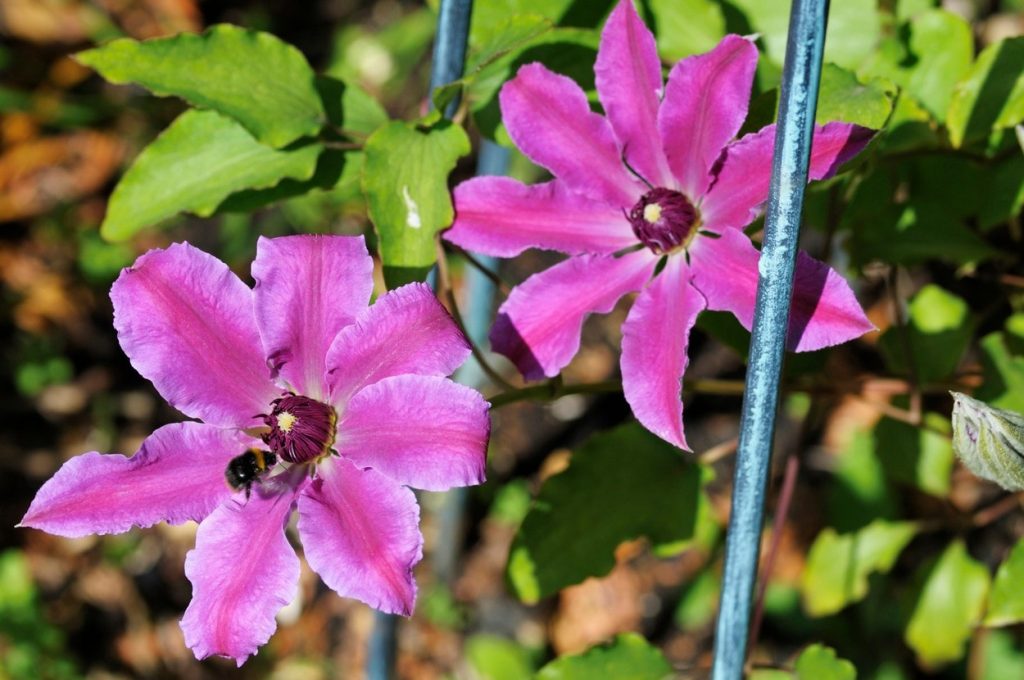
Clematis barbara
Watering
Loves moderate air humidity, does not tolerate drought, as a result of which the roots dry out quickly. During the period of active growth (spring and summer), the flower is often watered - once a week. Closer to autumn, watering is reduced to once every 15 days.
To do this, use warm and settled water.
Loosening and mulching
The next day, after each moistening, surface loosening is carried out to avoid the formation of a crust. Together with this procedure, the soil is weeded between the rows in parallel, weeds are removed.
At the very end, the plant is mulched with peat, humus or compost, which helps to prevent moisture evaporation, the growth of unnecessary vegetation.
Top dressing
In the first two years, the flowers are not fed, since the nutrients laid down during planting will be enough for further growth. In the third year of cultivation, nitrogen-containing preparations are introduced in early spring. At the stage of budding, they are fed with potassium, at the end of flowering - with superphosphate. Apply the dose indicated on the package. Fertilizers are used for garden ornamental flowering vines.
After carrying out a planned haircut, they are fed with a complex mineral composition, then with a solution of copper sulfate.
You cannot fertilize this crop during the period of active flowering - this can negatively affect the quality and duration of the process.
Additionally, in early spring, clematis is watered with milk of lime - a mixture of dolomite flour and chalk.
Support
They are installed during landing. They use different types of structures - arched, fan, trellis, pyramidal, mesh or cellular. Regardless of the type of construction, it is important that the support is strong and can withstand the weight of the overgrown crown.
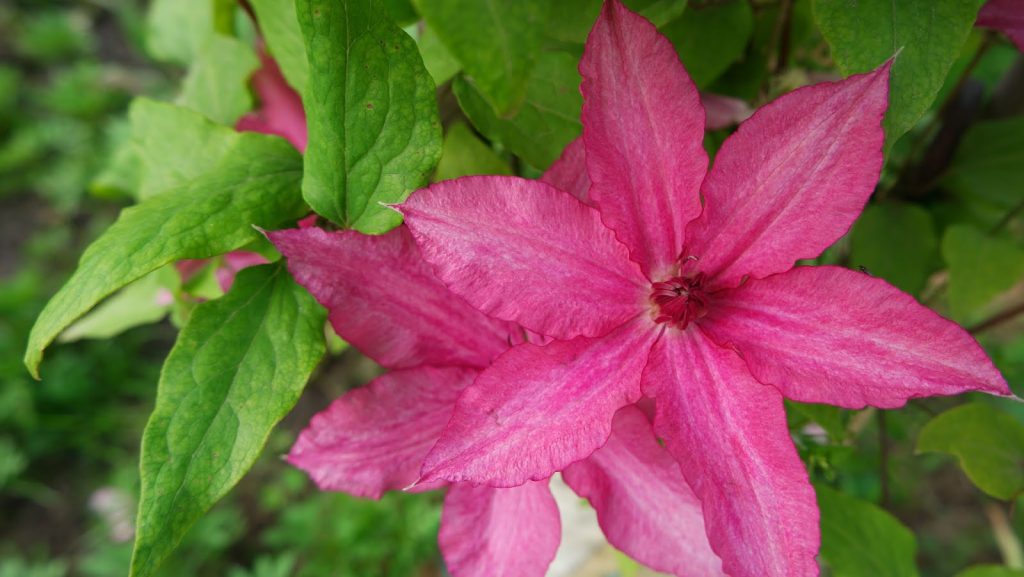
Clematis barbara reviews
The optimal diameter is 1-1.5 m. The lashes are tied as they grow to create a beautiful, lush and compact decoration.
Pruning
Regular haircut is essential to maintain the decorative crown and long-lasting flowering. There are three types of such a procedure that gardeners use for this vine:
- With the blooming of flowers on the shoots of the last season. The principle of pruning is to remove the generative areas and weak branches of the current season.
- For the appearance of buds on the branches of this and last year. Cutting is carried out in two stages. After the end of the first flowering, all last year's parts are cut out. With the arrival of autumn, a new generative growth is cut off.
- The third haircut is aimed at the formation of buds mainly on the branches of the current season. Pruned in the fall to the very first leaf or base of the shoots.
Any type of circumcision can be applied to this variety, it all depends on personal preference.
Such manipulations are carried out using a sharp and sterile pruning shears. Places of cuts are treated with a fungicide (solution of copper sulfate or Bordeaux liquid). This helps prevent infections and parasites from developing.
Shelter for the winter
The main task of every gardener is to protect the plant until spring. First, pruning is carried out, then clematis is warmed. Before the shelter, the foliage remaining on the shoots is cut off.
To avoid infection with infections in the winter season, the root neck is irrigated with a solution of iron or copper sulfate (2%). After drying, mulch with a thick layer of peat, humus or sand with the addition of wood ash. The height of the mound is 10-15 cm.
The crown is covered a couple of weeks before persistent cold weather. Breathable material is used - spruce branches, burlap or dry foliage. A wooden box is installed on top.
The insulation is removed in the spring as soon as the snow melts and the threat of recurrent frosts passes.
Diseases and pests
With good care, infection of clematis barbara dibley with infections and pests is extremely rare. This usually happens when plantings are thickened, diseased purchased flowers are planted, and growing rules are violated.
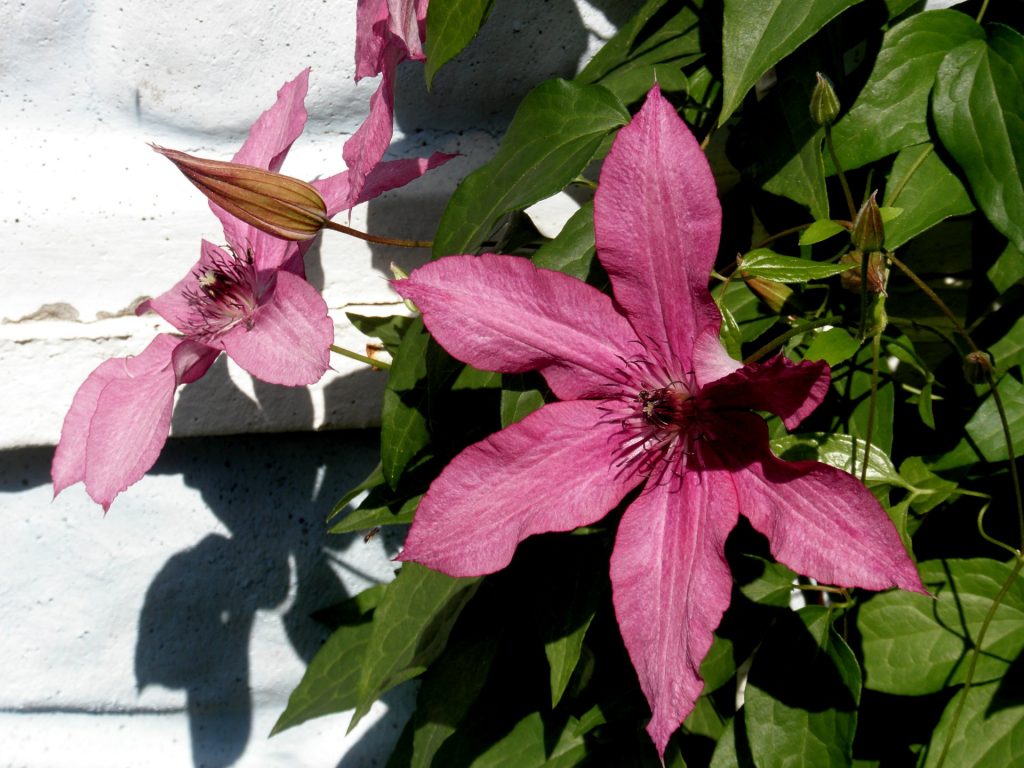
Clematis barbara photo and description
Affected by rust, powdery mildew, clematis are first cut off - the infected areas are cut out, then irrigated with a fungicide (copper sulfate or Bordeaux liquid).
When aphids, spider mites, thrips and whiteflies appear, insecticides are used - Aktellik, Aktaru, Karbofos or Fitoverm. All treatments are carried out in the evening and in dry weather.
For prevention, you must adhere to all the rules of care, buy healthy plants, follow the planting scheme, regularly examine for damage and remove infected stems, leaves and buds in time.
Reproduction methods
There are several ways to breed this vine, each with advantages and disadvantages.
Dividing the bush
For reproduction, grown plants from 3 to 6 years old are taken. The bush is watered abundantly, undermined, removed, washed off all the soil. The root system is divided into parts so that each has several roots, one stem with living buds.
Places of cuts are irrigated with copper sulfate, dried, planted in the same way as purchased flowers.
Layers
This procedure is started in the fall - in the first half of September. On an adult bush, the most flexible and strong shoot is chosen, all leaves on it are removed. They dig a trench 4-5 cm deep. Sprinkle with a mixture of peat and sand, lower the branch in a horizontal position, sprinkle it with earth, water it. A month before the onset of cold weather, the layers are mulched with a thick layer of fallen leaves or sawdust.
In the spring, when the snow thaws and the heat of the street stabilizes, the stem is dug up. Roots should appear on it. They are cut off from the mother plant, divided into several parts, so that each has 2-3 roots. Planted in a permanent habitat in the garden.
Seeds
This method is the most laborious, but if you do everything right, you can get more than a dozen seedlings at the same time. Take seeds of a 4-year aging period. Large seeds are sown in late February or early March, small ones - in April. For sowing, seedling boxes or plastic containers filled with a peat-sand mixture (1: 1) are used. The maximum seeding depth is 1 cm.
Seedlings are irrigated with warm water, covered with transparent film or glass. They are placed in a warm and well-lit place. After the appearance of greenery, the shelter is removed, grown until one pair of leaves develops, then dive into separate pots.
In the spring, as soon as the threat of recurrent frosts has passed, mature seedlings with several leaves and a stem are transplanted into open ground. The soil should be light, moisture and oxygen permeable. The scheme for planting seedlings is 15x20 cm. In order for the plants to begin to bush, they need to be pinched several times during the season.
In late autumn, they cover it - mulch with peat, then wrap it with sackcloth or cover it with spruce branches.
A transplant to a permanent habitat is necessary next year in the spring. Grooves are pulled out with a depth of 5-7 cm at a distance of 1.5 m from each other, transplanted by the method of transshipment of an earthen coma, and watered.
Application in garden landscape
This plant is very popular in several compositions:
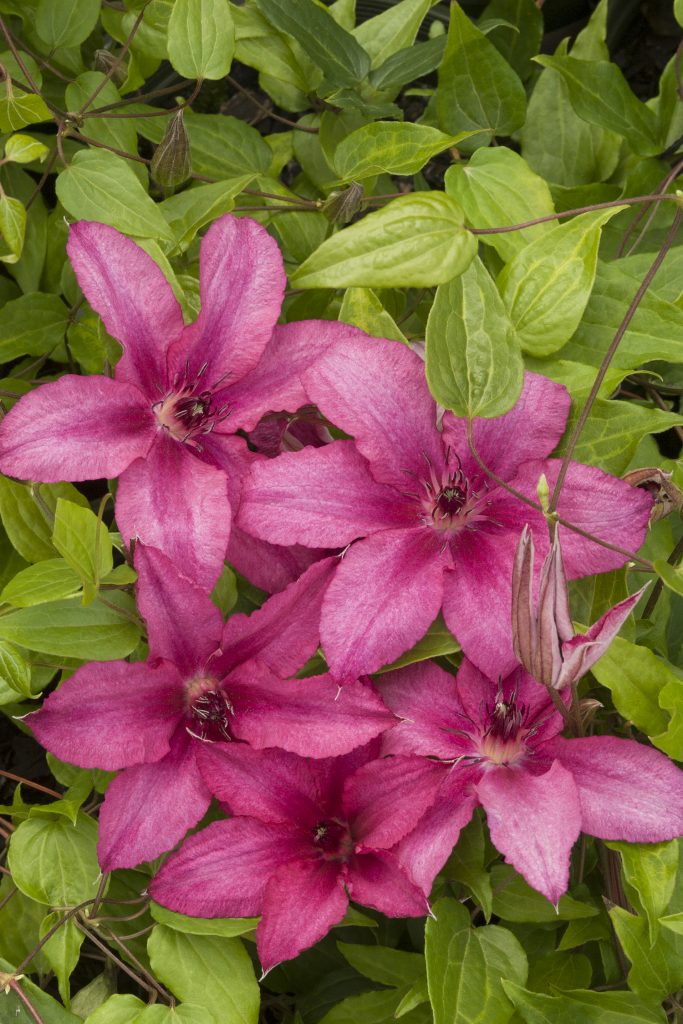
Clematis barbara jacman description
- bushy liana beautifully landscapes and decorates arches, gazebos, balconies, verandas, high walls;
- used as a hedge along fences;
- planted singly on flower beds, rocky slopes, lawns;
- often used to create rural, Japanese, English, Gothic styles.
Florist reviews
Decorative clematis Barbara Dibley pleases with thick greenery and bright colors all season, therefore she won the hearts of many flower growers:
- fast growth and good branching allows you to create a lush, dense and compact crown to decorate any corner of the garden;
- does not require special attention, grows well under direct sun, while it does not lose its decorative effect and continues to bloom magnificently;
- with good care, it is practically not damaged by diseases and parasites.

